
USF St. Petersburg campus Master's Theses (Graduate)
First Advisor
Major Professor: Dr. Richard Mbatu, Ph.D.
Second Advisor
Dr. James Ivey, Ph.D.
Third Advisor
Dr. Shawn Landry, Ph.D.
Fourth Advisor
Dr. Alvan Karlin, Ph.D.
Publisher
University of South Florida St. Petersburg
Document Type
Thesis
Publication Date
2019
Date Issued
November 15, 2019
Abstract
Analysis of the impacts of land-use change on streamflow is crucial for the sustainable development of water resources and land-use management practices. Specifically, the understanding of the urbanization impacts on streamflow will significantly help water resources and land-use managers and planners in decision-making processes. Therefore, this study was designed to analyze the potential impacts of future land-use change, specifically of urbanization on the streamflow of the Chipola River using the Soil and Water Assessment Tool (SWAT) in ArcGIS for four years (2015-2018). Implementing the SWAT model required 1) a digital elevation model (DEM); 2) land use maps from 2016 and future years; 3) a soil map; and, 4) meteorological data as inputs. Meteorological data included hourly rainfall, temperature (min., max.), wind, solar radiation, and relative humidity data. Scenario-based land-use change analysis was performed using two land use maps. A land-use map for the year 2016 was considered as the “baseline scenario” and was used to develop future land use maps, which represented the “future scenario” in this study. In developing a future land-use map, a five-mile buffer was developed along primary and secondary roads of the basin. It was assumed that low-density urban areas would be converted to high-density, and agricultural areas would be converted to low-density urban areas within the five-mile buffer. After inputting all the required data into SWAT, the model was run for four years (2015-2018) using the baseline scenario and the future scenario.
The SWAT streamflow outputs were calibrated and validated against real-world, observed streamflow data of the United States Geological Survey (USGS) stream gauge. The Sequential Uncertainty Fitting (SUFI-2) algorithm in SWAT Calibration and Uncertainty Procedures (SWAT-CUP) were used for calibration and validation. The recommended split data approach was used; one-half of the data (from 2015-2016) was used in calibration, and the other half of the data (from 2017-2018) was used in the validation process. Model goodness of fit was evaluated using the following statistical coefficients: 1) Nash Sutcliffe efficiency (NSE); 2) coefficient of determination (R2); and, 3) percent bias (PBIAS). These statistical analyses gave values of 0.81, 0.84, and 9.5 for calibration, and values of 0.76, 0.80, and -11.4 for validation, respectively. Defined evaluation criteria of these statistics suggest that values of NSE and R2 >0.75, while the value of PBIAS <10 is considered “very good.” Compared with the defined evaluation criteria, the calibrated and validated values represented successful calibration and validation of the streamflow of the Chipola River. After the successful calibration and validation of the SWAT outputs, calibrated parameters were written back to the original models of the baseline scenario and the future scenario. Results of calibrated streamflow between the two scenarios showed that there was an average increase of 2% streamflow between the selected years of study. The statistical difference of 2% in calibrated streamflow between the two land-use scenarios may suggest a positive link between urbanization and streamflow. This link between increased urbanization and streamflow of the Chipola River may provide useful information to land-use managers and planners designing policy for the Chipola Basin.
Creative Commons License

This work is licensed under a Creative Commons Attribution-Noncommercial-No Derivative Works 4.0 License.
Recommended Citation
Arif, Maryam, "Assessment of the Impacts of Land-use Change on Streamflow of the Chipola River" (2019). USF St. Petersburg campus Master's Theses (Graduate).
https://digitalcommons.usf.edu/masterstheses/190


Comments
A Thesis submitted in partial fulfillment of the requirements the degree of Master’s of Science in Environmental Science and Policy College of Arts and Sciences University of South Florida St. Petersburg